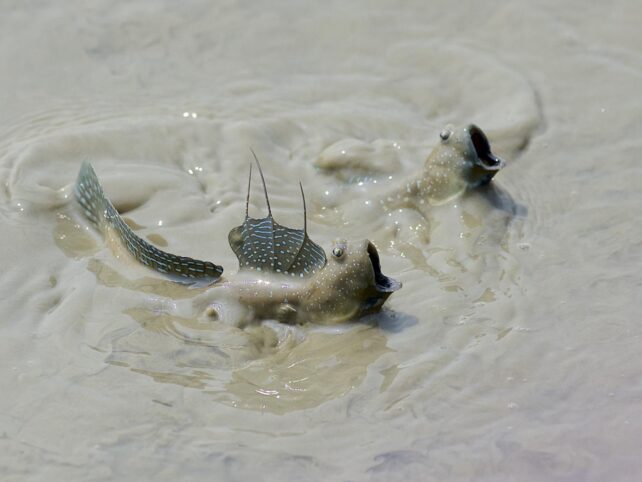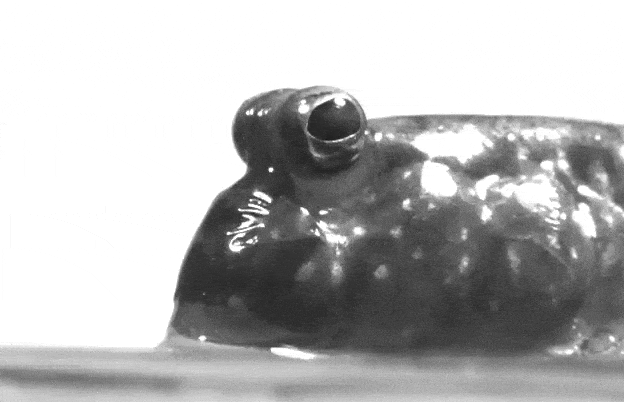Terrestrial animals do something that fish don't. Yes, OK, there's the whole walking around out of the water thing. But there is something else so small you do it without even knowing.
Most fish don't blink. They don't have the apparatus for it, the eyelids. They also don't need to blink since the water they swim in keeps their eyes moist and clean.
But there's one real oddball of a fish that doesn't just crawl around on land; it also blinks its bulbous eyes. We're talking, of course, about the amphibious mudskippers, and scientists are studying them to understand how blinking emerged from the water with our ancestors.
"Animals blink for many reasons," says biologist Thomas Stewart of Pennsylvania State University.
"It helps us keep our eyes wet and clean, it helps us protect our eyes from injury, and we even use blinking for communication. […] The mudskipper, which evolved its blinking behavior independently, gives us the opportunity to test how and why blinking might have evolved in a living fish that regularly leaves the water to spend time on land."
The ancestors of modern land tetrapods – four-limbed animals – crawled out of the water some 375 million years ago, a life change that necessitated some pretty dramatic physical adaptations, from locomotion to sensory perception.
One thing we observe in almost all land tetrapods, but not closely related aquatic animals, is blinking, suggesting that the behavior emerged as part of the suite of land-dweller adaptations.

There is a dearth of preserved eyelid and lacrimal tissue in the fossil record, which makes it difficult to ascertain exactly when and how blinking began. But there are some animals today that live sort of in between air and water, much like those early ancestors might have. Scientists turned to these to see if, and why, they blink.
Stewart, lead author biologist Brett Aiello of Seton Hill University, and their colleagues put Indian mudskippers (Periophthalmodon septemradiatus) and Atlantic mudskippers (Periophthalmus barbarus) in habitat tanks, with high-speed cameras set up to record as they went about their little mudskipper lives, moving between water and shore.
Mudskippers, unlike most fish, have protruding eyes, a bit like a frog's. The high-speed videos showed that mudskippers do blink and how they do it. The team also compared the anatomy of the mudskippers' eyes to those of similar fish that don't blink.
There are many different kinds of blinking in the animal kingdom, with variations of which membranes and how many of them close over the eye. Mudskippers blink by retracting their eye entirely down into the socket. When the eyeball is fully retracted, they are momentarily covered by a membrane called a dermal cup before the blink ends, and the eyes re-emerge.
"Blinking in mudskippers appears to have evolved through a rearrangement of existing muscles that changed their line of action and also by the evolution of a novel tissue, the dermal cup," explains Aiello.
"This is a very interesting result because it shows that a very rudimentary, or basic, system can be used to conduct a complex behavior. You don't need to evolve a lot of new stuff to evolve this new behavior – mudskippers just started using what they already had in a different way."
Next was to figure out why the mudskippers were blinking. Interestingly, they found that the mudskippers rarely blinked while underwater; they only did so when they bumped into objects in the tank, such as water filters or other mudskippers. Predominantly, they blinked while crawling about in the air.

Next, the researchers tested whether they were blinking because their eyes were dry. They increased airflow through the tank to increase the evaporation rate and observed an increase, not just in blinking, but in the rate at which mudskippers roll around on the wet ground to remoisten their bodies.
"We found that, just like humans, mudskippers blink more frequently when confronted with dry eyes," Aiello says.
"What's incredible is that they can use their blinks to wet the eyes, even though these fish haven't evolved any tear glands or ducts. Whereas our tears are made by glands around our eyes and on our eyelids, mudskippers seem to be mixing mucus from the skin with water from their environment to produce a tear film."
The researchers also tested other functions of blinking. They dusted dry brine shrimp eggs (it's very sand-like, something the critters are used to) onto the eyes of some of the mudskippers.
This triggered blinking as the mudskippers cleaned their eyes of the dusty irritant. And the researchers gently touched the mudskippers' eyes with soft probes, triggering a defensive blink to avoid damage.
It seems like a small thing, blinking. But vision is so essential to so many animals, and blinking performs several functions vital to the ability to see. Knowing when and how we started to do it helps us better understand the transition between water and land and what changes that transition wrought.
The mudskipper study suggests that the animals evolved blinking as a terrestrial behavior to accommodate the challenges of a different environment.
"Based on the fact that mudskipper blinking, which evolved completely independently from our own fishy ancestors, serves many of the same functions as blinking in our own lineage, we think that it was likely part of the suite of traits that evolved when tetrapods were adapting to live on land," Stewart says.
The research has been published in the Proceedings of the National Academy of Sciences.
"fish" - Google News
April 25, 2023 at 04:01AM
https://ift.tt/piMYCmE
This Amphibious Fish May Hold The Secret to The Evolutionary Origins of Blinking - ScienceAlert
"fish" - Google News
https://ift.tt/4vn7SEK
https://ift.tt/mw1dxtq
Bagikan Berita Ini















0 Response to "This Amphibious Fish May Hold The Secret to The Evolutionary Origins of Blinking - ScienceAlert"
Post a Comment